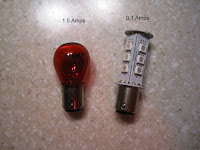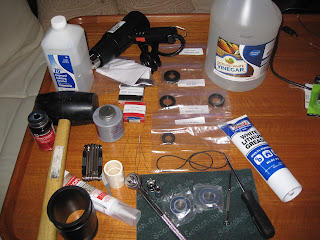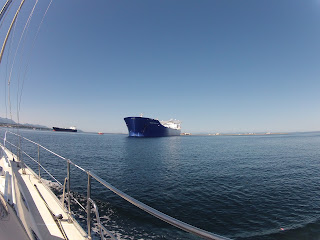Motor Maintenance
You will need:
Set of hex allen wrenches, 1/8, 1/4, 3/16"
7/16" 3/8" drive socket tool
Flat blade fine tip screw driver and flat standard screw driver
Razor blade
A medium heat source (heat gun)
Tube of GE clear silicone
Two 6203 RS sealed bearings
Scotch Brite pad for cleaning
Mild solvent or ISO alcohol for cleaning
Rubber mallet
One 2" PVC pipe coupling or piece of 2-2 1/2" non-magnetic tubing 3 - 4" in length
Four straightened paper clips or .06 diameter straight stiff wire 2" long
Permatex
Small bearing puller
3/4" small plastic pipe
Split the project into two days to allow time for silicone to cure.
Shut off power to windlass. Remove the two 3/16" socket head cap screws on the top of the black adapter housing. Using a heat source, raise the temperature of the adapter housing until the silicone bond is broken and the adapter housing can be removed. Clean the old silicone from all surfaces, adapter housing, as well as top of motor - this takes some time and is messy.
Motor is now free to slide off of the stainless steel downtube. The drive shaft components should all be lubricated when reassembled with an anti seizing lubricant. We used Permatex. Remove the large power conductors from posts at bottom of motor.
At the other end of the motor is the urethane motor terminal cover. Mark with a pen the location of the lower motor plate to the outer motor housing for reasembly purposes. It is wise to note the circular orientation of the motor boot to the motor so that the large electrical conductors realign themselves when you reinstall the motor. Remove the large clamp that goes around the cover and slide the motor terminal cover off. Clean any silicone sealant from the motor terminal cover.
There are two 7/16" head bolts which go through the length of the motor and clamp the motor together by screwing into the threaded motor end cap, remove these (turning counter clockwise) screws and withdraw them from the motor.
The motor end caps are now ready to separate from the middle field case. By striking the motor shaft with a soft mallet and holding onto the center motor case the brush holder end plate will be disloged and the upper motor end plate can be removed from the top of the motor.
With the top removed you can view the armature, at this point the brush holder end cap is still secured to the other end and held in place by the spring pressure of the brushes to the commutator. Do not remove the brush holder mechanism yet.
Place the PVC pipe coupler against the exposed armature and over the shaft end of the motor and place your other hand on the brush plate end, so as to hold the parts in column. The case will be held to the armature by the magetic field. While holding the parts together in column, turn them vertically with the non-magnetic tubing placed on a flat substantial surface. Using both hands grab the field case and slide down over the non-magnetic tube. The armature can now be separated from the magnetic field with the brush holder still attached.
You will see four holes visible externally from the end of the brush holder end cap. Remove the the silicone which is now filling these holes as they are the means of maintaining tension on the brush springs during reassembly. Take note of the brush spring and it's orientation.
Using the four straightened paper clips or wire, insert them into the holes. Retract the brushes all the way back in their brush retainers and push the wire through to engage the holes in the brush holder, thereby retaining the brushes under tension. The end cap can now be removed. Note: if the bearing stays mated to the armature, it can be removed using a small puller. We had to grind the puller down in order for it to fit. Make certain you do not loose the wave spring under the bearing.
Clean the armature using a mild solvent. It is preferred to use new 6203 ZZ style bearings when reassembling the motor to insure trouble free operation. We couldn't find the parts easily online and discussed needing parts for the maintenance with Hal (also a 1501 owner) at Mariner Supply (Go2Marine) and they created a kit for the Lighthouse windlass maintenance. You can order the parts here: http://www.go2marine.com/search.do?q=lighthouse. The shaft that the bearing fits to is .6693" so a piece of 3/4" plastic pipe can be used to relocate the bearings on the armature.
With the four straigtened wires holding the retracted brushes against the springs, blow or remove any dust from the brush holder mechanism. If corrosion is experienced in the brush holder mechanism (we did not have that), remove the wires and remove brush springs and emerse in white vinegar until gone. Then, rinse, dry and reassemble brush holder plate. Install brush holder mechanism on armature, making certain that wave spring is placed in bearing receptacle before bearing is inserted. Once brushes plate mechanism is installed on armature you can remove the wires. However, you can wait until final assemly to remove clips. Apply a small amount of electrical grease to the sides of the brushes.
Apply a bead of silicone to the mating surface of the brush holder/case junction. Seal the holes in the brush holder end, which you used for the paper clips/wire, with silicone.
Clean the magnet case of dust and inspect magnets for any cracking or looseness.
The reassembly is just the previous procedure reversed taking care to use silicone between mating surfaces, such as between the adapter housing and top of motor. Make sure and leave plenty of time for the silcone to dry before installing or it's a real mess.
Now align the timing marks and secure the two long motor connecting screws by only a thread or two. With the motor brush plate still not tight, apply a bead of silicone sealant around the motor shell to end plate joint - this can get messy depending on how much access you have to the motor. Now proceed by tightening the two screws, frequently turning the armature to make certain no binding can occur.
Install the urethane boot to its marked orientation using silicone sealant and tighten the sealing clamp - messy!
The motor is reinstalled.
We still have to complete the rest of the maintenance, but will wait for drier weather.
|
|
| Some of the items you will need for the project |
 |
Motor Installed
|
 |
| Remove the cables from the base |
 |
| Remove clamp |

 |
| Wires in the holes |



















































